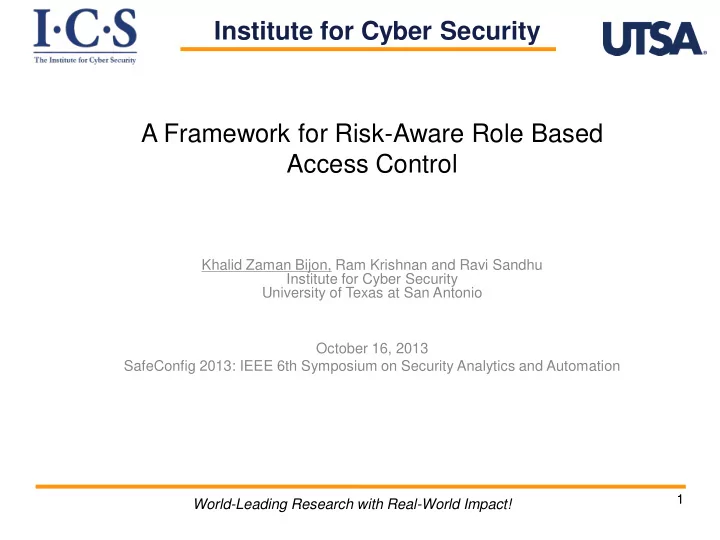

Institute for Cyber Security A Framework for Risk-Aware Role Based Access Control Khalid Zaman Bijon, Ram Krishnan and Ravi Sandhu Institute for Cyber Security University of Texas at San Antonio October 16, 2013 SafeConfig 2013: IEEE 6th Symposium on Security Analytics and Automation 1 1 World-Leading Research with Real-World Impact!
Traditional Organizations Access Control Mechanism 2 World-Leading Research with Real-World Impact!
General Access Control Systems S 1 Reference Monitor ……… S n Mediates all access User Subject/ Object requests Session Implemented Process (e.g., Alice, Resources to Access Control pid ), session Bob, etc. protect, e.g., models, e.g., (e.g., s ip ), mp3, doc, txt, RBAC, DAC, etc. directory. MAC. 3 World-Leading Research with Real-World Impact!
Modern Organizations ACM 4 World-Leading Research with Real-World Impact!
Intro. & Motivation Possible Solutions? Authenticate and grant same access everywhere Is not sufficient How do we know that the person in the other side is true employee Secure every place/situation by antivirus/firewalls Not scalable/feasible Impractical More dynamism in access control systems Accept/Deny accesses based on security threats/risks involve in every situations/places instead of always giving same outcome for a user 5 World-Leading Research with Real-World Impact!
Intro. & Motivation Overall Strategy Risk-Awareness in Access Control Systems Quantified Approach (Risk is represented as a metric) Calculate risk value, involved in every situation Grant access accordingly based on the estimated risk value 6 World-Leading Research with Real-World Impact!
Intro. & Motivation (cont.) Conducted Research in this Arena MITRE Corporation Jason Program Office. Horizontal integration: Broader access models for realizing information dominance (2004) Pioneer work in quantified risk-aware access control systems Risk-awareness in Access Control Systems: E. Celikel et al (2009), F.Salim et al (2011), L. Chen et al (2011), N. Baracaldo et al (2012), K. Bijon et al (2012), S. Chari et al (2012) and others: Risk-awareness in Role Based Access Control (RBAC) system (mainly focused on developing technique on risk- estimation and utilization) P. Cheng (2007), Q Ni (2010): Risk-awareness in Lattice Based Access Control (LBAC) R. McGraw (2009), Kandala et al(2011): Identify risk-factors for a risk-aware access control system H. Khambhammettu et al (2013): a framework for various risk-assessment approaches in access control 7 World-Leading Research with Real-World Impact!
A Framework for Risk-Aware RBAC The Framework Identify the Risk-Aware RBAC Components Faces different types of security risk while performing their operations Need to develop additional functionalities to support a risk-awareness Different Types of Risk-Awareness Traditional Approaches Quantified Approaches Non-adaptive approach Adaptive approach 8 World-Leading Research with Real-World Impact!
Risk-Aware RBAC Components Permission- User-Role Role Assignment Assignment (URA) (PRA) Constraints 9 World-Leading Research with Real-World Impact!
Risk-Awareness Types Traditional Approaches Constraints driven risk mitigation No explicit notion of risk value Quantified Approaches Risk is explicitly represented as a metric Risk is mitigated based on the estimated value 10 World-Leading Research with Real-World Impact!
Traditional Risk-Awareness RH 1. Administrative user needs to identify risky operations and generate constraints accordingly. (For example, a constraints can restrict two risky roles from assigning to same user (SSOD). 2. Static in nature (a constraint always 1. Static Separation of Duty (SSOD) gives same outcome, unless 2. Dynamic Separation of Duty (DSOD) modified) 11 World-Leading Research with Real-World Impact!
Quantified Risk-Awareness (Non-Adaptive) 1. Risk-threshold should vary across sessions (e.g. a session from office vs. session from home pc) 2. Risk-threshold limits user activities by restricting role- activation 12 World-Leading Research with Real-World Impact!
Quantified Risk-Awareness (Adaptive) 1. Continuous user-activities monitoring and anomaly detection 2. Response mechanism by automatic revocation of privileges (e.g. system automated role deactivation) 13 World-Leading Research with Real-World Impact!
Formal Specification Formally enhance NIST Core RBAC model − To support a session with adaptive risk-threshold Functions of the adaptive quantified risk-aware sessions − AssignRisk : assigns a risk value to a permission − RoleRisk : returns estimated risk of a role − CreateSession : user creates a session and system calculate risk-threshold for the session − AddActiveRole : called by users, tries to activate a particular − Deactivation : called by AddActiveRole to deactivate some already activated roles in order to activate that role − SActivityMonitor : This function monitors user sessions, if something is wrong it calls system automated deactivation (SADeactivation) function. − SADeactivation : This function automatically identifies which roles need to deactivate and asks user to deactivate them. 14 World-Leading Research with Real-World Impact!
Conclusion To Summarize the framework: The Risk-Aware RBAC Components are identified Sessions, User-Role assignments, Permission-Role assignments, Role Hierarchy, Constraints Each components should have different functionalities (need to be developed to support a Risk-Awareness) Different Types of Risk-Awareness Approaches Traditional Approaches Constraints specific (implicit risk and static in nature) Quantified Approaches Non-adaptive approach (explicit notion of risk that varies across different situations) Adaptive approach ( need run-time monitoring capabilities and additional system functions for automatic response) 15 World-Leading Research with Real-World Impact!
Future Work Permission- User-Role Role Assignment Assignment (URA) (PRA) Constraints 16 World-Leading Research with Real-World Impact!
The End Questions? 17 World-Leading Research with Real-World Impact!
Backup http://www.forbes.com/sites/danschawbel/2013/03/29/da vid-heinemeier-hansson-every-employee-should-work- from-home/
Recommend
More recommend